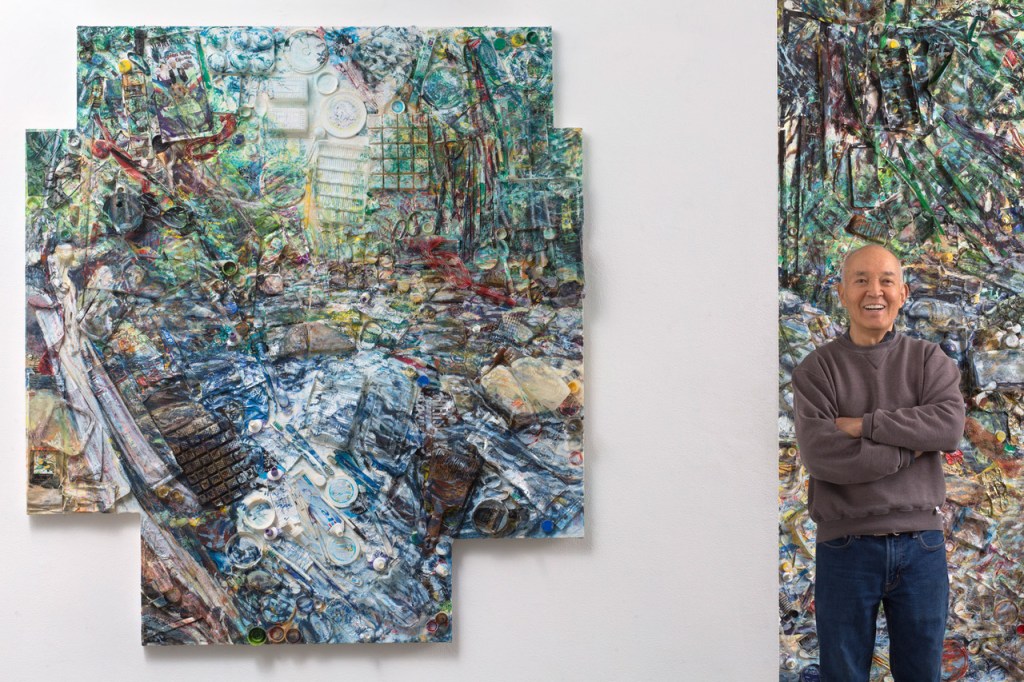
I met Bob in 1981 when I was in graduate school at Portland State University. Over the last 45 years we became best friends. We hiked, fished and taught together. We traveled to Sapporo to carve snow. We went to Thailand, Laos and Vietnam. We helped each other and grew together as artists and teachers. My mentor and teacher at PSU, Michihiro Kosuge, said that Bob was the best watercolorist he’d ever seen. I agree. His works demonstrate refined precision and immense skill.

Bob did life size figure drawings that were messy, energetic and elegant. He said, “Every bend or twist in my body shows up in my work. It is not an illusion of movement. Because I move the energy is recorded.” His earlier landscapes are a record of frenetic energy. We feel his dance, the chaos and rhythm of nature. Bob taught energy in the classroom. He wanted his students to feel alive. They would say, “Bob likes ugly drawings; he doesn’t like the pretty ones.” He gave his students one rule: “There are no rules in picture making.” His colleague, Ken Weeks states, “His drawings similarly strike to the heart of what, to me, makes a drawing alive and rich with possibility. They are dense and messy critters.”

Bob’s works grew in scale and energy. He and his wife Noriko produced very little garbage and recycled everything they could. All food scraps went into garden soil and nonrecyclables were used in his paintings. When I walked into his studio every conceivable thing was glued to his canvas. He told me these huge landscape paintings required five times more paint to cover all the surfaces. Once again, his frenetic energy would gain coherence in the composition. Fellow artist and friend George Johanson states, “…he overlays it all with an atmospheric landscape that is both at odds with the junk field and completely interlocked with it. One reads both separately then simultaneously. It is a dizzying display.”

Bob was an accumulator. His friend and artist Marie Watt states, “Here, then, is a third kind of accumulation: as he accumulates useful items on his desk and studio, as he accumulates everyday objects which are converted into art, Bob Dozono accumulates people and assembles them into a coherent, supportive community dedicated to the sharing of ideas. And this may be his greatest work: both as an artist and as a human being.”
Bob was all of these: a mentor, a patron, a colleague, a critic, a friend. He helped a lot of artists and students over the years. He bought my sculpture and commissioned me in times of need. He did the same for many others. He was an opulent, talented artist with a big, generous heart.
Bob received his Bachelor of Science in Fine Arts from the University of Oregon in 1969 and his Master of Fine Arts from Pratt Institute New York in 1971. He taught drawing, painting, basic design, gallery management, and survey of visual arts, and he served as Art Department Chair at Portland Community College from 1973 to 2001.

He exhibited extensively early in his career including watercolors, drawings and paintings at Portland Art Museum, Pacific Arts Center Seattle, Willamette University-Oregon, Maryhill Museum-Washington, Oregon History Museum, Clackamas Community College-Oregon, Mt. Hood Community College-Oregon, Lane Community College-Oregon, University of Oregon, Clark College-Washington, Rockford College-Illinois, Marylhurst University-Oregon, Newport Arts Center-Oregon.
Bob was a member the Blackfish Gallery in Portland from 1986 to 2020 where he had numerous solo, two-person and group shows. His works are currently in several public and private collections including the Portland Visual Chronicles and the Chronicles of Lake Oswego. He also showed internationally at the Chinese University of Hong Kong and Prague-Czech Republic.

Bob’s later shows at Blackfish Gallery reflected his love of nature and his concern for environmental and social issues. He created very large-scale drawings and paintings that progressively grew in size and energy. He referred to these as his “garbage” paintings, the largest of which were more than eleven feet by eleven feet. He said he got a lot of exercise going up and down the ladder all day. Bob worked on his opus, No Farm-No Food-Take Back America-Upper Clackamas #11, from 2009 to 2022 and exhibited it at Blackfish Gallery several times over the course of its completion. This painting captures every aspect of Bob’s tenacity, energy, skill and determination.

Bob might say that none of his works were ever finished. They captured a moment in time, an energy that flowed through him.
The memorial for Bob Dozono is on June 21st at 1 pm at the Amo de Bernardis College Center on the PCC Sylvania campus (12000 SW 49th Ave, Portland OR 97219).


